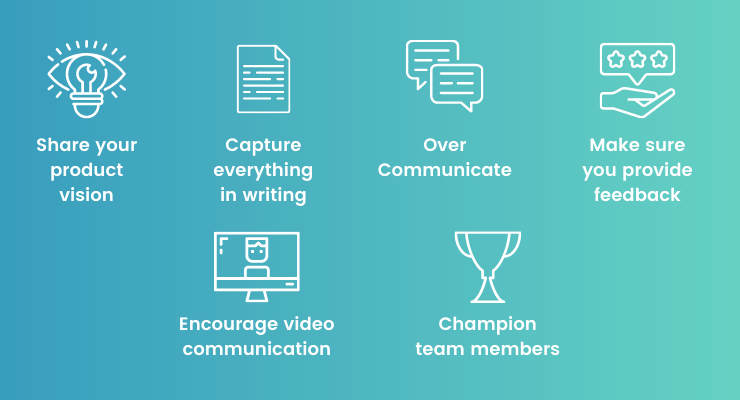We're in an era where working remotely is becoming increasingly common. Many businesses, in fact, have totally remote teams. Remote teams allow companies to tap into a larger talent pool and allow everyone to work where and how they are most productive.
With effective communication, the right tools, and a remote-first culture, remote engineering teams can avoid these issues and deliver significant benefits and create more-effective software teams.
This article we discuss how you can overcome the challenges inherent in managing remote engineering teams based on our own experience at SoftKraft, where the remote-first approach allows us to attract the best talent and scale engineering teams on demand.
Challenges For Remote Engineering Teams
Anyone who has tried to manage, or take part in, a remote team will know that there are some problems that arise. However, with the right information and the right approach, these challenges can be tackled, leading to a smooth remote collaboration experience.
Keeping everyone in the loop can be harder than you think
Slow and inefficient communication seeps into work, creating dependencies where a member can’t move on. Everyone on your team should understand what a project status, current priorities and what their colleagues are working on.
Poor planning impedes project delivery
Project success can be uncertain if planning is poor. If you don't properly communicate your plan or requirements with your team.
In the office, it seems to be easier to set goals and make decisions, such is the collective energy of the room. As well as this, it’s easy to spot if a member of the team isn’t quite understanding what the plan is, and therefore it is easier to do something about this.
Team building
Most CEOs will agree that bringing new members of a team into the office is a great way for them to get a feel for the culture of the company. With remote engineering teams this is not possible, of course. So how do we introduce new team members in a way that is going to help them to understand the feel of the company and get to know better wit their team members?
Best strategies for managing a remote team
With all of these hindrances in mind, it’s super important that we consider the best ways to overcome them so that we can run the most efficient and productive sessions possible while being away from the workspace.
Actually, if we can do this, several advantages begin to arise. There are some positive things about working remotely. In a way, managing remote engineering teams can actually be a lot better than holding meetings in the workplace.

Share your product vision (visually)
The business value of the end result also depends on how well you communicate the business objectives. Your focus is business benefits. The offshore team's focus is meeting its obligation. If your business objectives are understood as part of their obligation, then you will have a project environment that encourages innovation.
Best practices
- Clearly state success definition. Probably the most important aspect is both parties being aligned in what success looks like. If it’s at all unclear what you want to achieve at the end, rewrite it.
- Show top level user journey walkthrough. This urges the offshore team to adopt a more user-centric approach and better relate sprints/milestones deliverables to the big picture
Capture everything in writing
Start with sharing plans, roadmaps, and project updates with the team. This means writing a lot down, and making information discoverable, allowing efficient knowledge transfer to remote workers when they need it. It also means being deliberate about when to use asynchronous and synchronous communication for discussions and decisions.
Asynchronous communication is recommended as it separates availability from ability to participate in discussions and decisions. People must be able to unplug without losing important decisions.
Best practices
- Make notes from every meeting and share them on internal communication channels
- Create Google Docs for longer-form notes and technical design documents
- Replace daily meetings with a written summary on team communication channels: work done yesterday, plan for today and blockers.
- Encourage remote team members to announce departure during workday. For example, we use #presence channel on Slack where people let their colleagues know when they leave their desk. Remote colleague's absence is less obvious.
Over Communicate
Leaving the offshore team in the dark from time to time is almost inevitable. Casual office chat could lead to a minor change in the project, which may not be relayed immediately to the offshore team. Make it a point of duty to over communicate.
Best practices
- Make good use of daily meetings. Ensure you stay in touch with the offshore team. Daily scrum meetings is a good way to start
- One-on-ones. Don't just stop at daily scrum meetings. If needs be, talk one on one with team members. This ensures that they're getting their work done and you can assist if there's something you can help with.
- In-house communicator. Assign someone in-house to ensure that the offshore team gets all the info they could possibly need. This person's roles would be to keep an eye on any changes to the project and communicate to the offshore team.
Encourage video communication
There is a hierarchy when it comes to effective communication tools. Video and audio calls/conferences are the best choice for speed and efficiency. Whenever possible, prioritize video and audio over text and email.
Remote work can be done from literally anywhere — and you don’t need to have the perfect office to be professional. However, you should encourage people to choose a place where they can feel comfortable sharing video.
Best practices
- Encourage using headsets or earbuds with microphone as they offer clear voice and limit external noises.
- Encourage people to pick a good place for video conferences that have neutral background, no bright lights or sunlight streaming in, and no random passers-by.
Champion team members
Remote people can fall into the trap of being “out of sight and out of mind”. Be a people's champion. Mention their name and good work to your manager, peers, and on team meetings. Give them credit, advocate for them, help them become more visible. Relationships and teamwork take time and effort. In the end, their visibility is dependent on them and you for career advancement and long-term retention.
Best practices
- Provide frequent, just-in-time employee recognition. Make sending an email or calling to say “good job” the norm for your team. This sort of micro-recognition helps create a culture of support and shows your team you see how hard they’re working.
- Encourage them to give each other positive feedback to introduce peer recognition to your remote team. This could be as simple as an email thanking a co-worker or a shout-out in a virtual meeting.
- Share the praise you’ve received from stakeholders, users, and customers. When you receive praise for a project that was worked on by an offshore team, don't fail to send this praise across to them.
Make sure you provide feedback
Further to communication, feedback to the team as a whole and individual members of it is key. This needs to happen all the time, perhaps even more so than it would in the office, as it’s going to be more difficult for a team member to see how they are doing if they are not in the building.
The type of feedback is important too. It’s useful to find the right balance between positive and negative feedback (depending on the performance of the individual). Constantly condemning a team member will lead to poor morale whereas constant praise can lead to complacency.
Best practices
- Provide feedback timely. It's best to praise an employee's accomplishment right away. Timeliness is also important for negative feedback – except when an employee has done something truly wrong. Delaying your complaint until you've cooled down may be wise in this case. This will help you give objective, non-emotional feedback.
- Discuss the situation, not the person. Constructive feedback focuses on results and objective observations, not the employee's personal traits. Personal feedback could be interpreted as an attack motivated by emotions rather than facts.
Tools for managing remote engineering teams
Now that we’ve checked out some team-building strategies, it’s time to look at some specific tips for how to manage remote developers within a remote team.

Schedule
Having coordinated meeting times is even more important when working remotely than it is in the office. If everybody turns up and pays attention to the meeting, this is one of the only ways to know that they are engaged with the project. As we have just discussed, engagement leads to better productivity and overall, a better project.
To build a successful schedule, you’ll need to consider the individual timetables of each member of your team as well as any clients or outsourced developers you are looking to work with. Put together a daily plan as well as a weekly and monthly agenda that suits these timetables.
Something to look at here would be a scheduling tool, and we recommend either Google Tools or Doodle. However, there are plenty of other options out there should you wish.
Organise
Leading on from the idea of scheduling, we need to go a little further to make sure that the members of our teams are staying engaged while they are not in the office. To help with this, you’ll need to synchronise the team to ensure the best possible workflow.
Ideally, you’ll want to get the best members of your team working on whatever their skills are best suited to, but at the very least, you’ll want to ensure that everybody is doing their fair share of the work so that sections of the project get over the line on time and everybody stays motivated off the back of one another.
A couple of great tools to help with this are Google Tools once again and Trello, an excellent piece of software for working on remote tasks. Another good one to check out is Basecamp.
Synchronization
Trello and other tools can really help you to synchronize as a team, but the best thing to help here is consistent, clear communication. Right off the bat, you’ll want to make sure that everybody is on the same page about how often to communicate and how this communication is going to go down.
Establish a group chat on a professional platform such as Slack or Loom and encourage participation. It would be wise to set a friendly atmosphere in this chat so that you can keep up team morale while communicating any updates that come about. At the same time, encourage communication and feedback from others so that everybody feels like their voices are being heard.
Meetings
Web chat is one thing, but communication and synchronisation can only go so far using the medium of text. A lot of the time, holding meetings using video calls is the best way to communicate things to one another and have feedback received.
The format of video is important here. Your team members are going to be much more engaged when they can see one another and be seen, and while it may be unfair to force team members to turn their videos on, a gentle suggestion could go a long way on this front.
Meetings are more formal than text chat and this has its benefits, but both should be run alongside one another. Holding a meeting should only be called with a clear purpose in mind such as a beginning or end of day check-in or a substantial update that requires communication. Holding too many meetings for little or no reason is only going to frustrate your team when they feel like they could be using that time to get other things done.
A couple of great ideas for video communication are Google Meets, Zoom or Microsoft Team. Each of these has their own benefits that can help you and your team in different ways, so take the time to do some research so that you can find out which one is going to be best for you.
Collaboration
Off the back of these meetings, you can encourage remote collaboration. When this is done right, it can be one of the most effective ways to run a project.
In a team collaboration meeting, you can run ideas by one another, plan and strategize to get the best out of your project. Have someone take notes throughout so that you remember what has been discussed to instantly act on it.
Check out Mural and Miro for a great setup.
Growing Remote Engineering Teams with SoftKraft
With Team Augmentation, our team becomes an integral part of your team. We carefully select each team member based on the requirements and expertise you need. They immerse themselves in your project, maintaining your company culture and working in line with your strategic goals.
Engage quality tech professionals
We are driven by 15+ years of experience in IT staff augmentation and engineering software solutions.
Fast process: CVs within 3 days
Time and cost savings - receive first CVs of our specialists and start interviewing candidates.
Risk-free 2 weeks trial
To get rid of any doubts, check the quality of your team with no obligation to pay with 2-weeks trial.
Conclusion
Managing remote engineering teams has countless benefits and when it is done right, can be invaluable to the success of your next project. But what about bringing on those new team members as and when you need them?
At Soft Kraft, you can reach out for support to get any section of your project over the line, whether it be from start to finish or for individual sections. Get in touch with us today to see how we can help you remotely.







